Back
DIY PCB Manufacturing
In answer to the frequently asked question about how I
make my Printed Circuit Boards (PCB's)
I make almost professionally looking PCB's since years, the
only thing I can't do by myself is the silkscreen mask.
The basic PCB material I use is presensibilized with a UV sensible lacquer
(available in most electronic stores).
You can also use non presensibilized PCB material and treat it with Positiv20
spray from Kontakt Chemie. De-oxidate and de-grease the raw PCB material with
steel wool and aceton. Atomise a FINE layer of Positiv20 onto
the copper and let the PCB dry for 24 hours in ambient room temperature, or
about an hour at a maximum of 70°C (do not exceed! ). I do
this in my hot air electric oven in the kitchen.
The drying MUST be done in complete darkness! After that the
PCB can be used as normal presensibilized PCB.
All you need is:
-
A
software to develop your PCB layouts. I use
the demo version of
Circad'98
from Holophase because of its ease of use.
I also recently bought the cheap Sprint-Layout software from
Abacom.
-
(Preferably) A laserprinter to print the darkest
possible printouts of your PCB layout on transparent slides.
I always print out two identical and mirrored slides, so that the
tonerside of the upper slide will be in direct contact with the UV-sensible
lacquer side of the PCB material (against parasitic UV light between slide
and lacquer), and staple them very precisely together.
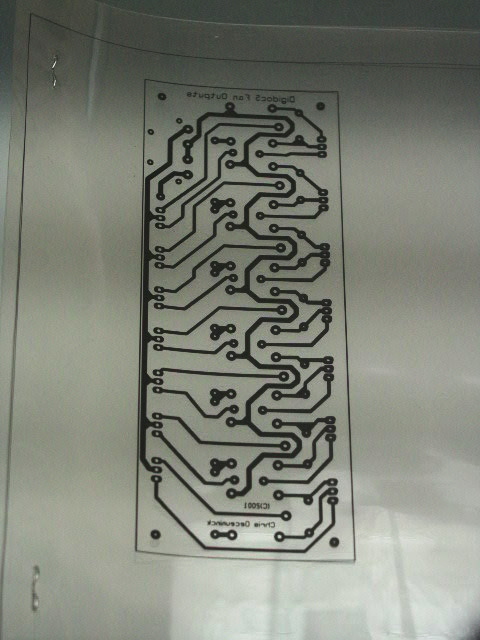
-
A
UV-exposure unit to expose the PCB material to
(short wave) UV light.
The optimal wave length should be between 370 and 440 nm, with my Sylvania
350 blacklights that output their peak wave length at 356 nm, it works just
fine. Beware these are no blacklights as we know from dancing clubs or
case modding, the lamp is just white coated as any other TL lamp when it's
powered off. Powered on it emits a clear blue-ish light (very bad for your
eyes!).
This is my DIY UV-exposure unit, equipped with 4x 20W TL tubes (the unit
is almost 20 years old now!).
In the meanwhile the timer on the picture has been replaced by my DIY
microcontroller based timer.
The same results can be obtained with two tubes of 8 or 15W, only exposure
timings will be longer.
Also, do not forget to preheat the lamps during 10 minutes to obtain their
maximum light output.
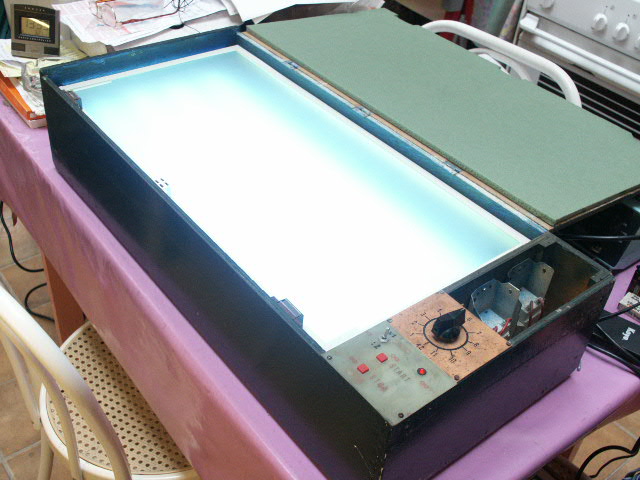
Placement of the PCB material and slides:

Some more pictures of my UV-exposure unit:
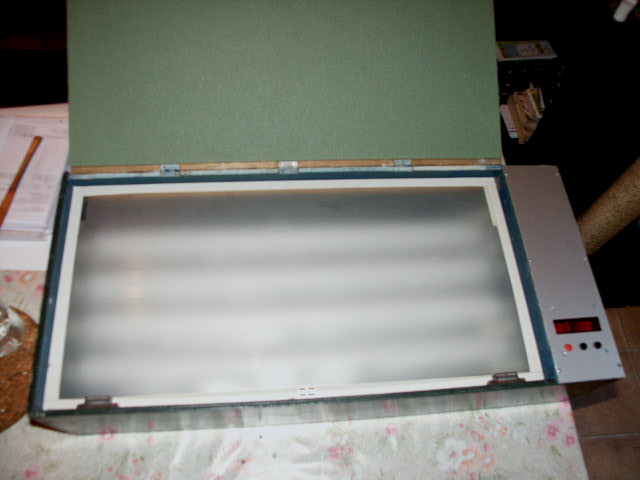
The PIC16F84 based Timer:
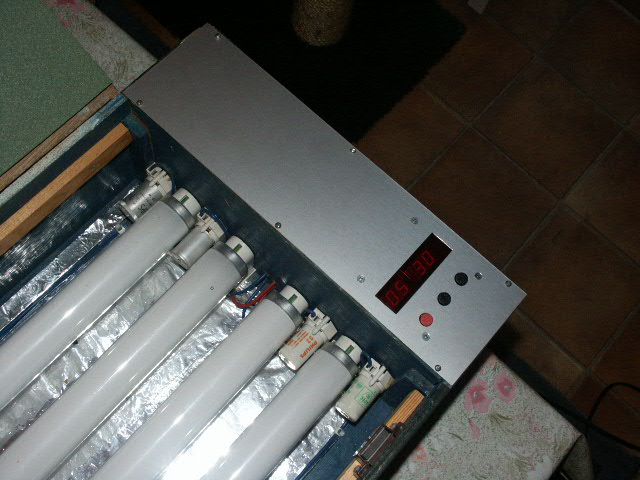
View of the 4 UV-lamps:
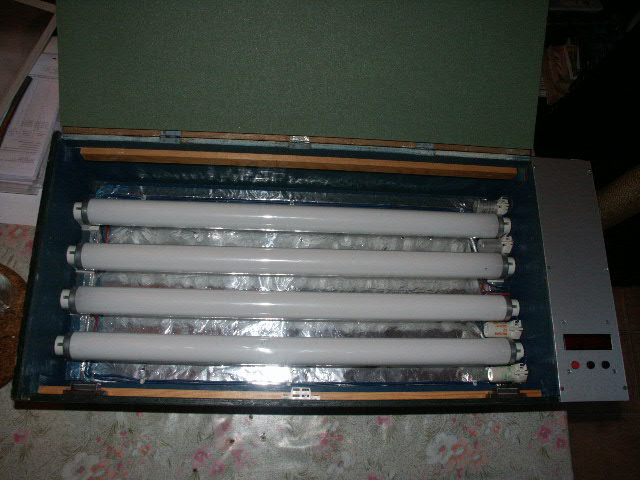
Lamps powered on:
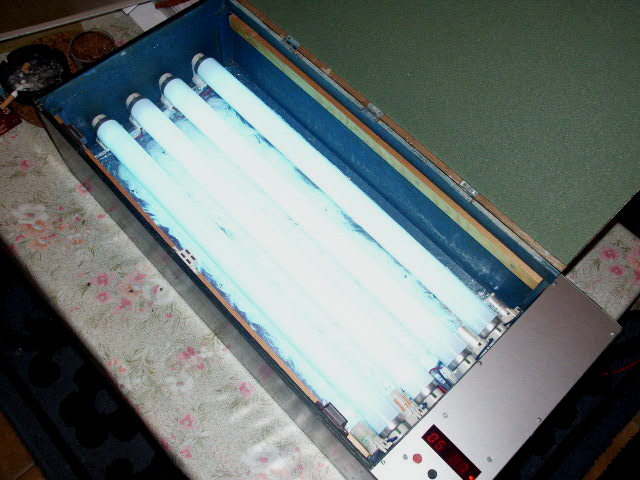
The used glassplate is "milky" to diffuse the UV-light from the
lamps:
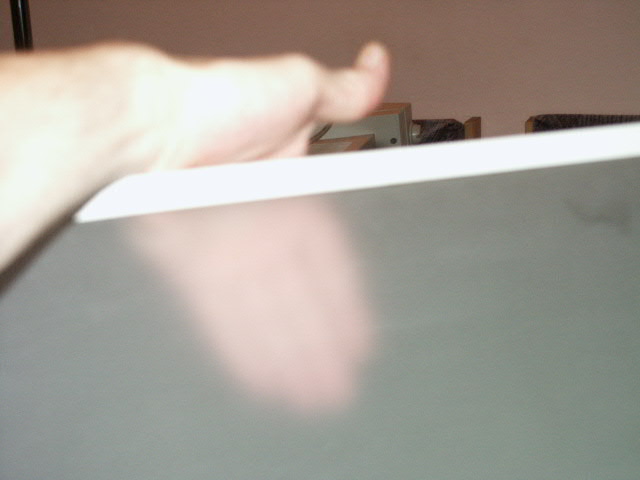
Slides in place onto the glassplate (with toner upwards):
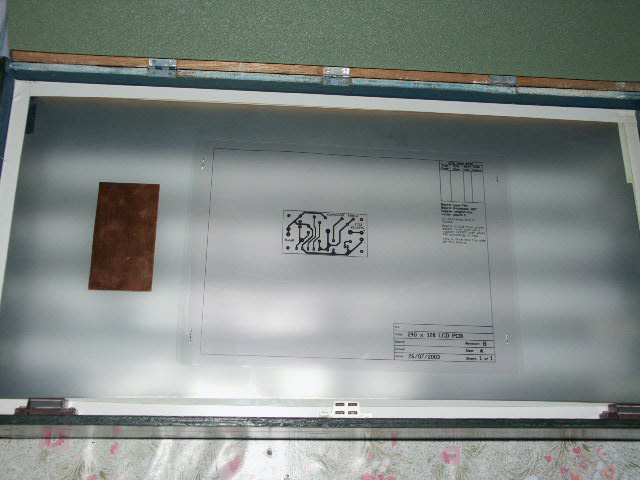
PCB material in place onto the slides, ready to be exposed:
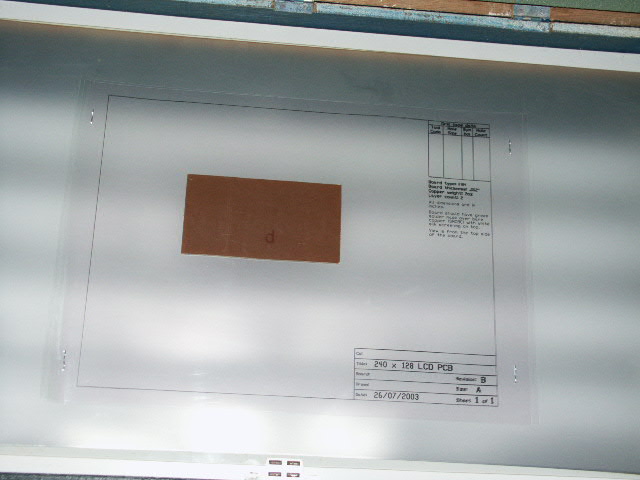
To determine the "best" exposure time for the UV exposure I did the
following:
-
Take a slide with a PCB layout.
-
Put a piece of cardboard on 9/10 of the surface.
-
Expose for 1 minute.
-
Move the cardboard to 8/10 of the surface.
-
Expose for 1 more minute.
-
Move the cardboard to 7/10 of the surface.
-
Expose for 1 more minute. And so on...
-
Develop the exposed PCB.
-
Examine the results and decide for the best exposure time.
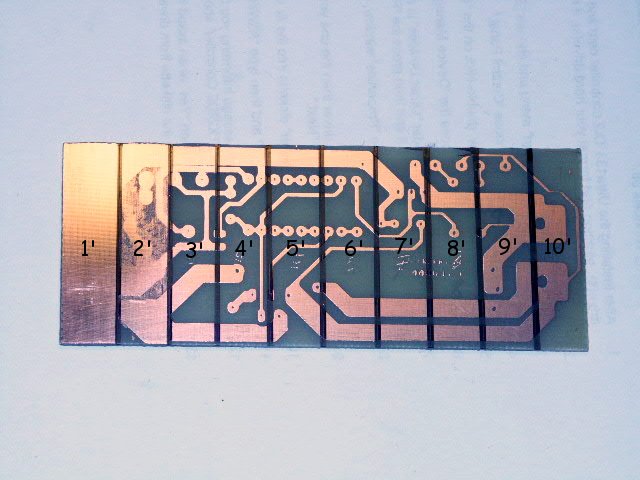
In my case the best exposure time is between 5 and 6 minutes, so I decided for
5min 30secs. I didn't fail any PCB since then...
-
A "tupperware " container to develop the exposed PCB.
After exposure the PCB has to be developed in a solution of sodiumhydroxide
(NaOH + water).
Sodiumhydroxide under the form of pellets or flakes is also called caustic
soda.
Pre-packaged bags of sodiumhydroxide to dilute in 1 liter of warm tapwater are
available at most electronic stores. (I tried with caustic soda and water but
it didn't work out very well...I've found that either all or none of the
lacquer dissolves)
Pour it into a "tupperware" container big enough to hold the PCB so that the
developer is shallow.
You can see the PCB developing (the developer goes blue as soon as the exposed
lacquer is dissolving) and the drawing of the layout will become clearly
visible on the copper.
Rinse the PCB under flowing tapwater.
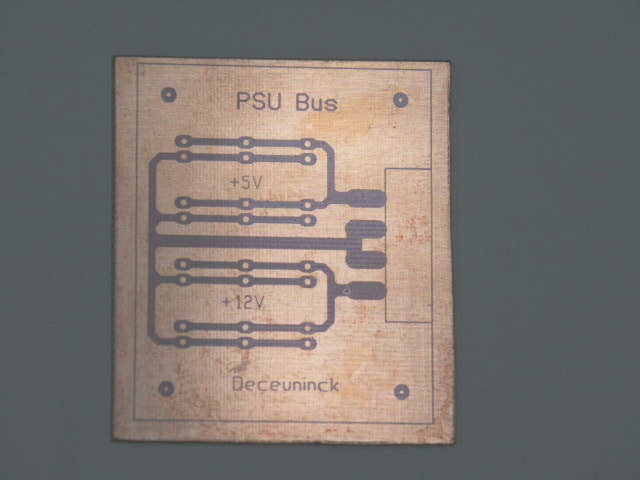
The development should be finished within a minute (typically about 30 seconds
at 20-25°C) After more than a few minutes the non exposed areas of the lacquer
will begin to dissolve too.
The developer in the tupperware should be used only ONCE! (use
fresh developer for every new PCB to develop)
-
A "tupperware" container to etch the PCB.
Etching of the PCB in a Ferric Chloride acid solution (Fe2CL3 + Water),
available at electronics stores under the form of yellow-brownish grains to
dilute in 1 liter of warm water, again in a "tupperware" container disposed in
a "bain marie" (hot water recipient).
I use my kitchen sink filled with some hot water to obtain a temperature of
about 50°C.
Ferric Chloride acid is more effective when its temperature rises, and
therefore etching times decrease. Continuously moving the tupperware so that
the etchant is flowing over the PCB also decreases drastically etching time.
(with a fresh Ferric Chloride solution the etching time can go as low as 8-10
minutes).
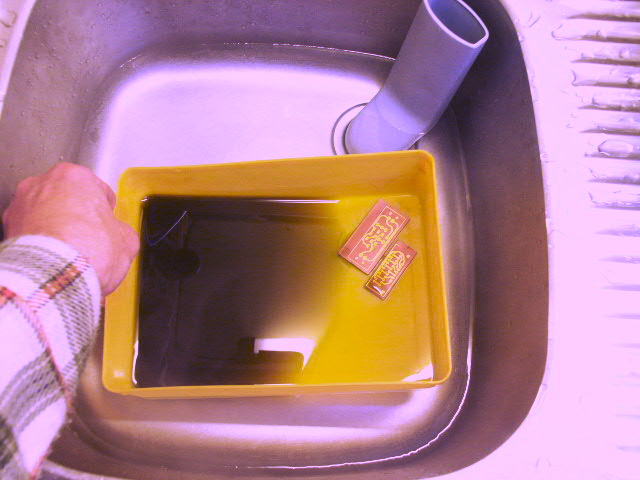
-
A metalsaw and a minidrill.
After the etching process the PCB has to be cut, filed and sandpapered to the
right dimensions.
Drilling of the PCB holes (OMG, I hate this...), beginning with a 0.8mm drill
(suitable for resistors, little capacitors, transistors, IC's, to 1.0, 1.2 and
1.3mm for bigger components.
I use a 12 to 18V - 100W Maxicraft mini drill and the accompanying drill
standard (very easy) powered by my
PWM speed controller for mini drills project.
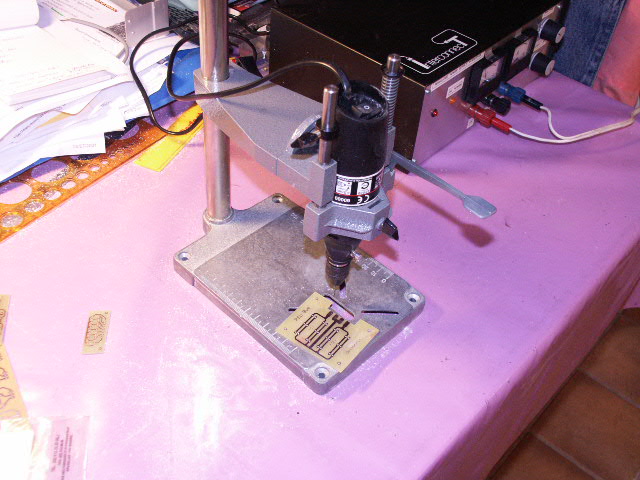
Some finished PCB's:
Since the copper is still covered by the UV lacquer it's protected against
oxidation and moisture, and also the lacquer acts as a (not very good) solder
flux when soldering the components to the PCB.
I prefer to remove the lacquer with aceton (ask your wife or girlfriend...),
solder the components, and then treat the solder side with a spray varnish (I
use transparent Plastic Spray 70 from Kontakt Chemie and green varnish from
KF).
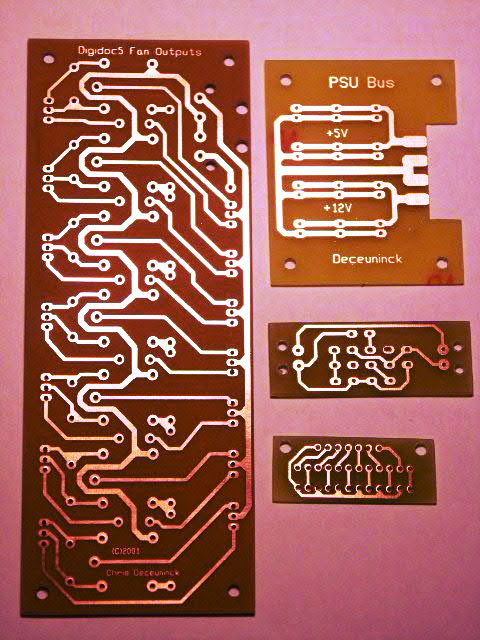
A few weeks ago I bought also a new TBM220 mini bench drill machine from
Proxxon for about 250 Euro.
Not cheap but very precise:
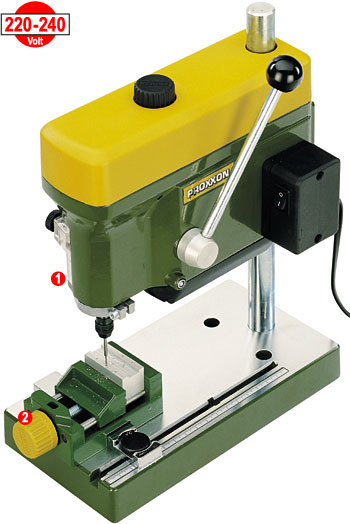
Back
















